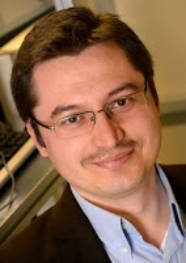ANION EXCHANGE MEMBRANE DESIGN FOR REVERSE ELECTRODIALYSIS
Promotion date: January 31.
Promotor: Prof.dr.ir. Kitty Nijmeijer
| Reverse electrodialysis (RED) is a clean, sustainable, and thus promising and potentially attractive technology, for the generation of energy from the mixing of solutions with different salinity. It utilizes the free energy of mixing these solutions (e.g. river water and seawater) to generate power. In RED, a concentrated salt solution and a less concentrated salt solution are brought into contact through ion selective membranes (anion exchange membranes, AEMs, and cation exchange membranes, CEMs) that are alternately patterned in a stack. Anion exchange membranes allow only anions to pass through towards an anode, and cation exchange membranes allow only cations to pass through towards a cathode. At the electrodes a redox couple is used to provide the transfer of electrons through an external circuit, thus creating power. The ion exchange membranes are key elements in RED. Especially the study of anion exchange membranes is crucial since the fabrication is complex, and limited research has been done specifically for RED. This PhD thesis investigates the design and development of the RED process, with a special focus on fabrication, characterization and optimization of anion exchange membranes. Different membrane properties and characterization methods were studied and implemented. The directions towards how to tune membrane properties specifically for RED are defined. The results suggest that PECH (polyepichlorohydrin) membranes are good materials for a viable RED process. Very low area resistances with good permselective properties were obtained in a single-step process. With this study, for the first time, it was shown that tailor-made anion exchange membranes were installed in a RED stack, which increased the power density from the mixing of seawater and river water. |
I presume your PhD work was highly application driven?
Yes it was, though a great deal of scientific creative work was done as well. Anion exchange membranes are difficult to fabricate as it requires multiple steps. The membranes available in the market are by far not optimal for reverse electrodialysis purposes.
We created, characterized and built a novel production method, from scratch. It was fascinating to actually detect the potential differences resulting from the stacks with our membranes built into it, which we fabricated out of rubber: polyepichlorohydrin. It is good feeling to see that the demo in the lab is still being used now in publicity events, showing potential students what we are capable of in our Membrane Group.
Our research was a targeted project supported by two companies: Wetsus and Fujifilm Membranes. This research has led to a pilot plant agreed to be built in the near future. First of all a 50 kW plant is taken into production to overcome the first operational problems. After that even bigger pilot plants are agreed upon.
The capacity in the Netherlands for providing electricity using RED is quite high, some estimate as up to 200 MW plants at various locations around the country. As in Holland salt water and freshwater at only short distances apart, are widely available, this kind of blue energy facility at “de Afsluitdijk” is able to fulfill the electricity needs of three northern provinces in the Netherlands I believe. This kind of blue energy fits the Netherlands especially well.
Did you manage to have some nice articles published?
Several articles were published in which I was the first or second author. These were in: Energy Procedia Journal, ChemSusChem and the Journal of Membrane Science.
In what way did you develop personally, as a researcher and scientist?
In my master work the role of the supervisor was decisive, in the strategic decisions and planning procedures. Here, in the PhD project, I worked independently and made the creative decisions by myself, even though the project targets were set beforehand.
Of course the meetings with the supervisor and the accompanying board were crucial. Nevertheless the most strategic developments I had to decide and plan by myself. I felt more happy to do so as the project proceeded.
Also I learned to deal with the master students involved in our work. They all differ in level of working and personality. Academic work in this field is not just about making good membranes but also it is important to add some good psychology when collaborating with students and colleagues.
What are your future plans?
Now, I am working at Wetsus in a post-doc position. Here we work on sodium-selective membranes for irrigation water applications in greenhouse systems. We perform some preliminary studies. After that we plan to fabricate these membranes. That is quite a challenge as we will be the first to fabricate this kind of membranes.
After that I would like to apply for a R&D job or a managerial position connected towards R&D. Development of new technologies and invention processes in an industrial environment are of importance to me when thinking about my future work.
What in your opinion is important for Mesa+ to stay successful in future?
It was a great experience to be part of the Mesa+ institution. Although our work at molecular synthesis is somewhat specialized, everywhere around the world scientists and other people know about Mesa+ and have a good general feeling of the investigations taking place here, at various nano scale levels.
So, Mesa+ is doing a great job in communicating internationally. Nevertheless I feel some gain is possible scaling the organization into a next professional level. Supporting departments - concerning human resources, purchasing and strategic communication - should collaborate closely, with one vision to enforce the unique ‘”selling points” of Mesa+ as a renowned institution.

